Search Thermo Fisher Scientific
Invitrogen
p21 (WAF1, Cip1) Polyclonal Antibody, eBioscience™
FIGURE: 1 / 15
p21 (WAF1, Cip1) Antibody (14-6715-81) in ICC/IF
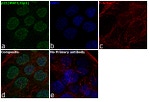
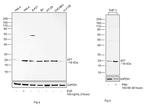
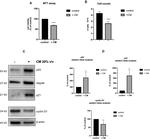


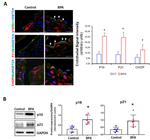
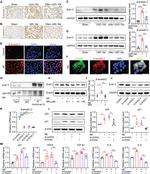
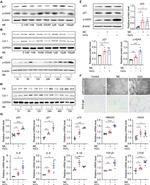
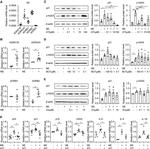
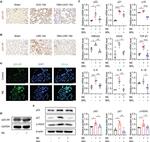
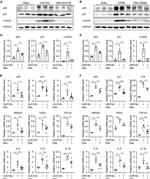
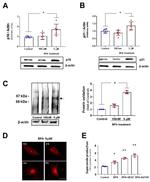
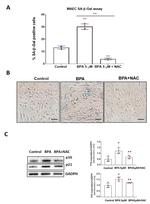
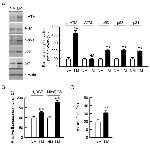

Product Details
14-6715-81
Species Reactivity
Published species
Host/Isotype
Class
Type
Conjugate
Form
Concentration
Purification
Storage buffer
Contains
Storage conditions
Shipping conditions
RRID
Product Specific Information
Description: The polyclonal antibody reacts with mouse, rat, and human p21; the antibody was raised against a peptide mapping to the carboxy terminus of human p21. The progression through the cell cycle is regulated by cyclins and their cognate Cdks by promoting cell cycle transitions (1,2,3). This orderly progression can be inhibited by a family of proteins known as CDK inhibitors (CDIs) that bind to cyclin/Cdk complexes and halt cell division (3). p21 (also designated WAF1/Cip1) is one has been shown to inhibit the activity of each member of the cyclin/Cdk family and over expression of this protein inhibits the proliferation of mammalian cells (5). The expression of p21 is inducible by a wide range of stress stimuli and its transcription can be enhanced by p53 (6). Another member of the CDIs is p27 (also known as Kip1), which also sees up regulation in response to antimitogenic stimuli (7). The increased protein expression of p27 results in cellular arrest by binding to cyclin/Cdk complexes, like cyclin D1/Cdk4 (4,8). An additional CDI has been found to bind Cdk4 and Cdk6, p16 (INK4A), and when such complexes are formed, the progression of the cell cycle is halted (9). It has become increasingly clear that p16 is a very important tumor suppressor gene whose frequent loss occurs early in many human cancers. p16 is a major target in carcinogenesis that is rivaled in frequency only by p53 (10).
Applications Reported: Purified anti-mo/hu/rat p21 (WAF1/Cip1) poly has been reported for use in immunoprecipitation, immunoblotting (WB), and immunohistochemical staining.
Applications Tested: Purified anti-mo/hu/rat p21 (WAF1/Cip1) poly has been tested by immunoblotting (WB) (1:200 starting dilution).
Purity: Greater than 90%, as determined by SDS-PAGE.
Aggregation: Less than 10%, as determined by HPLC.
Filtration: 0.2 µm post-manufacturing filtered.
Target Information
Protein p21 is a tumor suppressor protein which is an inhibitor of Cyclin-dependent kinases (CDK) and is transcriptionally activated by p53. P21 is important in the response of cells to genotoxic stress and a major transcriptional target of p53 protein. The occurrence of p21 in the nucleus executes binding and inhibition activity of cyclin dependent kinases Cdk1 and Cdk2, and blocks the transition from G1 phase into S phase or from G2 phase into mitosis after DNA damage, which enables the repair of damaged DNA. In the cytoplasm, p21 protein has an anti-apoptotic effect. P21 is able to bind to and inhibit caspase 3, as well as the apoptotic kinases ASK1 and JNK. P21 exhibits a dual function in carcinogenesis, and acts as a tumor suppressor, prevents apoptosis, and acts as an oncogene.
For Research Use Only. Not for use in diagnostic procedures. Not for resale without express authorization.
Bioinformatics
Protein Aliases:
Activating Fragment 1; CDK-interacting protein 1; CDK-interaction protein 1; CDNK1A; Cip1); Cyclin-dependent kinase inhibitor 1; Cyclin-dependent kinase inhibitor 1A (p21; cyclin-dependent kinase inhibitor 1A (P21); cyclin-dependent kinase inhibitor 1A (p21, Cip1); cyclin-dependent kinase inhibitor 1A variant 1; cyclin-dependent kinase inhibitor 1A variant 2; DNA synthesis inhibitor; MDA-6; melanoma differentiation associated protein 6; Melanoma differentiation-associated protein; Melanoma differentiation-associated protein 6; OTTHUMP00000016298; p21; p21
Gene Aliases: CAP20; CDKI; CDKN1; CDKN1A; CIP1; MDA-6; MDA6; P21; p21CIP1; p21WAF; PIC1; SDI1; UV96; WAF1
UniProt ID: (Human) P38936, (Mouse) P39689
Entrez Gene ID: (Human) 1026, (Mouse) 12575, (Rat) 114851

Performance Guarantee
If an Invitrogen™ antibody doesn't perform as described on our website or datasheet,we'll replace the product at no cost to you, or provide you with a credit for a future purchase.*
Learn more
We're here to help
Get expert recommendations for common problems or connect directly with an on staff expert for technical assistance related to applications, equipment and general product use.
Contact tech support
